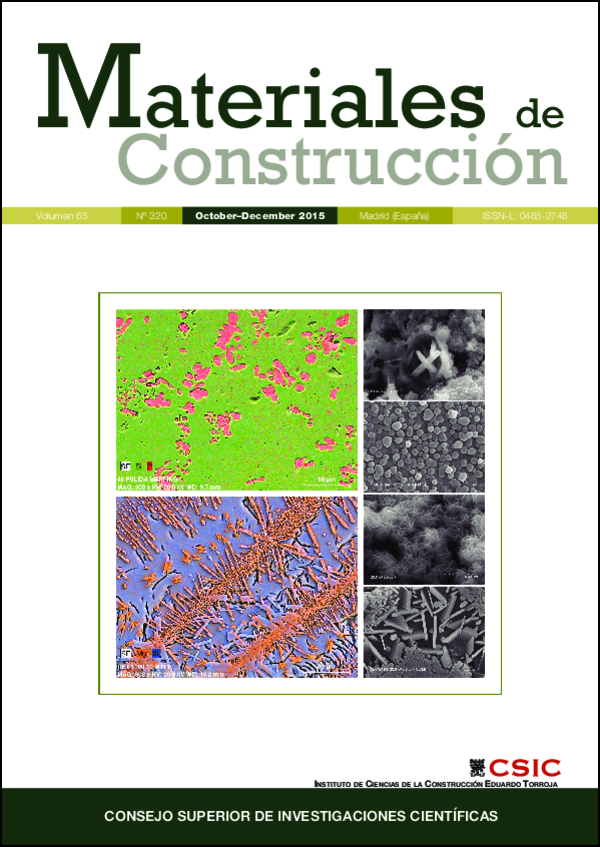Estudio calorimétrico de las etapas iniciales de la hidratación del silicato tricálcio- nanosílice. Efecto de la temperatura
DOI:
https://doi.org/10.3989/mc.2015.06814Palabras clave:
Calorimetría, Silicato tricálcico, Hidratación, Temperatura, NanosíliceResumen
El estudio de la reacción puzolánica de la nanosilice en contacto con C3S se siguió por calorimetría de conducción isotérmica. Puesto que la temperatura modifica dicha reacción, también se analizó dicho efecto (25 °C, 40 °C y 65 °C). Los resultados obtenidos mostraron que la adición de nSA al C3S acelera su hidratación, del mismo modo que cuando se aplica temperatura de curado. Sin embargo, la adición de nSA acelera la hidratación del C3S en mayor medida que la temperatura de curado. Además, la adición de nSA conduce a una reducción del periodo de aceleración durante la hidratación del C3S y por tanto conduce a una temprana precipitación de portlandita y también a una temprana precipitación y nucleación de gel C-S-H.
Descargas
Citas
1. Lin, L-K.; Wu, W-S.; Lee, H. (2013). Value analysis and properties investigation of high performance rice husk ash concrete. Adv. Mat. Res. http://dx.doi.org/10.4028/www.scientific.net/amr.773.293
2. Fairbairn, E.M.R.; Americano, B.B.; Cordeiro, G.C.; Paula, T.P.; Toledo Filho, R.D.; Silvoso, M.M. (2010). Cement replacement by sugar cane bagasse ash: CO2 emissions reduction and potential for carbon credits. J. Environ. Manag. 91, 1864–1871. http://dx.doi.org/10.1016/j.jenvman.2010.04.008
3. Thomas, J.J.; Jennings, H.M.; Chen, J.J. (2009) Influence of Nucleation Seeding on the Hydration Mechanisms of Tricalcium Silicate and Cement. J. Phys. Chem. C 113, 4327–4334.
4. Sáez del Bosque, I.F.; Martín-Pastor, M.; Martínez-Ramírez, S.; Blanco-Varela, M.T. (2013) Effect of temperature on C3S and C3S+ nanosilica hydration and C-S-H gel structure. J. Am. Ceram. Soc. 96, 957–965.
5. Kontoleontos, F.; Tsakiridis, P.E.; Marinos, A.; Kaoidas, V.; Katsioti, M. (2012) Influence of colloidal nanosilica on ultrafine cement hydration: Physicolchemical and microstructural characterization. Constr. Build. Mater. 35, 347–360.
6. Ozyildirim, C.; Zegetosky, C. (2010) Exploratory investigation of nanomaterials to improve strength and permeability of concrete. Transport. Res. 2142, 1–2148.
7. Land, G.; Stephan, D. (2012) The influence of nano-silica on the hydration of ordinary Portland cement. J. Mater. Scienc. 47, 1011–1017.
8. Tashima, M.M.; Soriano, L.; Monzó, J.; Borrachero, M.V.; Akasaki, J.L.; Payá, J. (2014) New method to assess the pozzolanic reactivity of mineral admixtures by means of pH and electrical conductivity measurements in lime:pozzolan suspensions. Mater. Construcc. 64, e032.
9. Wadsö, L. (2010) Operational issues in isothermal calorimetry. Cem. Concr. Res. 40, 1129–1137.
10. Quennoz, A. (2011) Hydration of C3A with Calcium Sulfate Alone and in the Presence of Calcium Silicate. Thesis doctoral. EPFL.
11. Barnes, P. (1983). Structure and Performance of Cement. Applied Science Publishers, London, UK.
12. Taylor, H.F.W. (1997) Cement Chemistry. Academia Press, London, U.K.
13. Makar, J.M.; Chan, G.W. (2008) End of the induction period in ordinary portland cement as examined by high-resolution scanning electron microscopy. J. Am. Ceram. Soc. 91, 1292–1299.
14. Juilland, P.; Gallucci, E.; Flatt, R.; Scrivener, K. (2010) Dissolution theory applied to the induction period in alite hydration. Cem. Concr. Res. 40, 831–844.
15. Sato, M.; Diallo, F. (2010) Seeding Effect of Nano-CaCO3 on the hydration of Tricalcium Silicate. Transportation Research Record 2141, 61–67. http://dx.doi.org/10.3141/2141-11
16. Noor-ul-Amin; Alam, S.; Gaul, S.; Muhammad, K. (2013) Hydration mechanism of tricalcium silicate (alite). Adv. Cem. Res. 25, 60–68.
17. Bullard, J.W.; Jennings, H.M.; Livingston, R.A.; Nonat, A.; Scherer, G.W.; Schweitzer, J.S.; Scrivener, K.L.; Thomash, J.J. (2011) Mechanisms of cement hydration. Cem. Concr. Res. 41, 1208–1223.
18. Thomas, J.J.; Biernacki, J.J.; Bullard, J.W.; Bishnoi, S.; Dolado, J.S.; Scherer, G.W.; Luttge, A. (2011) Modeling and simulation of cement hydration kinetics and microstructure development. Cem. Concr. Res. 41, 1257–1278.
19. Thomas, J.J. (2007) A New Approach to Modeling the Nucleation and Growth Kinetics of Tricalcium Silicate Hydration. J. Am. Ceram. Soc. 90, 3282–3288. http://dx.doi.org/10.1111/j.1551-2916.2007.01858.x. http://dx.doi.org/10.1111/j.1551-2916.2007.01858.x
20. Bishnoi, S.; Scrivener, K.L. (2009) μic: A new platform for modelling the hydration of cements. Cem. Concr. Res. 39, 266–274.
21. Zakoutsky´, J.; Tydlitát, V.; Cerny, R. (2012) Effect of temperature on the early-stage hydration characteristics of Portland cement: A large-volume calorimetric study. Constr. Build. Mater. 36, 969–976. http://dx.doi.org/10.1016/j.conbuildmat.2012.06.025
22. Sáez del Bosque, I.F.; Martínez-Ramírez, S.; Blanco-Varela, M.T. (2012) From 30 May to 1 June. Influencia de la relación agua/sólido en la hidratación del silicato tricálcico y de dos cementos portland comerciales (Influence of the water/solid ratio on C3S hydration and two portland cement). In XII Congreso Nacional de Materiales - IBEROMAT XII. Alicante, Spain.
23. Hewlett, P.C. (1988). Lea's Chemistry of Cement and Concrete. Elsevier, Oxford, U.K.
24. Nazari, A.; Riahi, S. (2011) The effects of Cr2O3 nanoparticles on strength assessments and water permeability of concrete in different curing media. Mater. Sci. Eng. A 528, 1173–1182.
25. Alizadeh, R.; Raki, L.; Makar, J.M.; Beaudoin, J.J.; Moudrakovski, I. (2009) Hydration of tricalcium silicate in the presence of synthetic calcium-silicate-hydrate. J. Mater. Chem. 19, 7937–7946.
26. Yu, P.; Kirkpatrick, R.J.; Poe, B.; McMillan, P.F.; Cong, X. (1999) Structure of calcium silicate hydrate (C-S-H): Near-, Mid-, and Far-Infrared Spectroscopy. J. Am. Ceram. Soc. 82, 742–748. http://dx.doi.org/10.1111/j.1151-2916.1999.tb01826.x
Publicado
Cómo citar
Número
Sección
Licencia
Derechos de autor 2015 Consejo Superior de Investigaciones Científicas (CSIC)

Esta obra está bajo una licencia internacional Creative Commons Atribución 4.0.
© CSIC. Los originales publicados en las ediciones impresa y electrónica de esta Revista son propiedad del Consejo Superior de Investigaciones Científicas, siendo necesario citar la procedencia en cualquier reproducción parcial o total.
Salvo indicación contraria, todos los contenidos de la edición electrónica se distribuyen bajo una licencia de uso y distribución “Creative Commons Reconocimiento 4.0 Internacional ” (CC BY 4.0). Consulte la versión informativa y el texto legal de la licencia. Esta circunstancia ha de hacerse constar expresamente de esta forma cuando sea necesario.
No se autoriza el depósito en repositorios, páginas web personales o similares de cualquier otra versión distinta a la publicada por el editor.
















